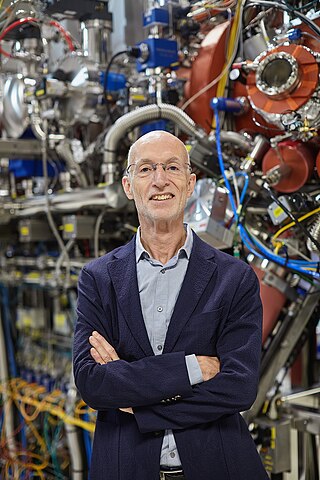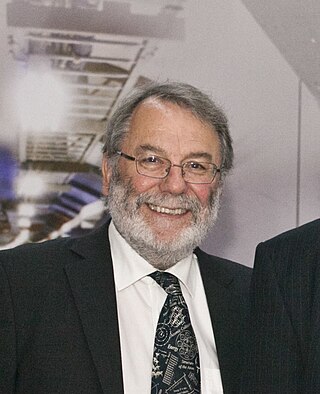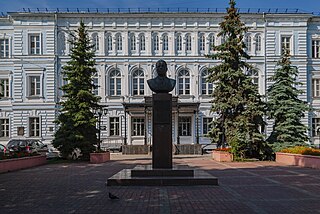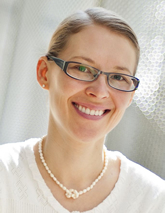Related Research Articles
Optica is a professional society of individuals and companies with an interest in optics and photonics. It publishes journals, organizes conferences and exhibitions, and carries out charitable activities.

Stuart Stephen Papworth Parkin is an experimental physicist, Managing Director at the Max Planck Institute of Microstructure Physics in Halle and an Alexander von Humboldt Professor at the Institute of Physics of the Martin-Luther-University Halle-Wittenberg.
Xi-Cheng Zhang is a Chinese-born American physicist, currently serving as the Parker Givens Chair of Optics at the University of Rochester, and the director of the Institute of Optics. He is also the Chairman of the Board and President of Zomega Terahertz Corporation.

Sir Peter Leonard Knight is a British physicist, professor of quantum optics and senior research investigator at Imperial College London, and principal of the Kavli Royal Society International Centre. He is a leading academic in the field of quantum optics and is the recipient of several major awards including the Royal Medal from the Royal Society and the Thomas Young Medal and Prize from the Institute of Physics. He is a former president of the Institute of Physics and Optica, the first non North American-based person to take the position.

The National Research State University of Nizhny Novgorod named after N.I. Lobachevsky, UNN, also known as Lobachevsky University, is a public research university in Nizhny Novgorod, Russia, and one of the biggest classical universities of the country. The university is ranked 1,455th in the world in the U.S. News & World Report Best Global Universities 2022-2023.
Girish S. Agarwal, Fellow of the Royal Society UK, is a theoretical physicist. He is currently at the Texas A & M University with affiliations to the Departments of Biological and Agricultural Engineering, Physics and Astronomy, and the Institute for Quantum Science and Engineering. Earlier he worked as Noble Foundation Chair and the Regents Professor at the Oklahoma State University. He is a recognized leader in the field of quantum optics and also has made major contributions to the fields of nonlinear optics, nanophotonics and plasmonics. In 2013 he published the textbook "Quantum Optics", covering a wide range of recent developments in the field, which has been well received by the community.

Constance J. Chang-Hasnain is chairperson and founder of Berxel Photonics Co. Ltd. and Whinnery Professor Emerita of the University of California, Berkeley. She was President of Optica in 2021.
Andrea Alù is an Italian American scientist and engineer, currently Einstein Professor of Physics at The City University of New York Graduate Center. He is known for his contributions to the fields of optics, photonics, plasmonics, and acoustics, most notably in the context of metamaterials and metasurfaces. He has co-authored over 650 journal papers and 35 book chapters, and he holds 11 U.S. patents.

Teri W. Odom is an American chemist and materials scientist. She is the chair of the chemistry department, the Joan Husting Madden and William H. Madden, Jr. Professor of Chemistry, and a professor of materials science and engineering at Northwestern University. She is affiliated with the university's International Institute for Nanotechnology, Chemistry of Life Processes Institute, Northwestern Initiative for Manufacturing Science and Innovation, Interdisciplinary Biological Sciences Graduate Program, and department of applied physics.

Anurag Sharma is an Indian physicist and a professor at the department of physics of the Indian Institute of Technology Delhi. He is known for his pioneering researches on optoelectronics and optical communications and is an elected fellow of all the three major Indian science academies viz. Indian Academy of Sciences, Indian National Science Academy and National Academy of Sciences, India as well as Indian National Academy of Engineering. The Council of Scientific and Industrial Research, the apex agency of the Government of India for scientific research, awarded him the Shanti Swarup Bhatnagar Prize for Science and Technology, one of the highest Indian science awards for his contributions to Engineering Sciences in 1998.
Olga Anatolevna Kocharovskaya is a distinguished professor of physics at Texas A&M University, known for her contributions to laser physics, quantum optics and gamma ray modulation.

Donna Theo Strickland is a Canadian optical physicist and pioneer in the field of pulsed lasers. She was awarded the Nobel Prize in Physics in 2018, together with Gérard Mourou, for the practical implementation of chirped pulse amplification. She is a professor at the University of Waterloo in Ontario, Canada.

Mona Jarrahi is an Iranian Engineering professor at the University of California, Los Angeles. She investigates novel materials, terahertz/millimeter-wave electronics and optoelectronics, microwave photonics, imaging and spectroscopy systems.
Jelena Vučković is a Serbian-born American professor and a courtesy faculty member in the Department of Applied Physics at Stanford University. She served as Fortinet Founders Chair of the Department of Electrical Engineering at Stanford University from August 2021 through June 2023. Vučković leads the Nanoscale and Quantum Photonics (NQP) Lab, and is a faculty member of the Ginzton Lab, PULSE Institute, SIMES Institute, and Bio-X at Stanford. She was the inaugural director of the Q-FARM initiative. She is a Member of the National Academy of Sciences, and a Fellow of The Optical Society, the American Physical Society and the Institute of Electrical and Electronics Engineers.

Alexandra Boltasseva is Ron And Dotty Garvin Tonjes Distinguished Professor of electrical and computer engineering at Purdue University, and editor-in-chief for The Optical Society's Optical Materials Express journal. Her research focuses on plasmonic metamaterials, manmade composites of metals that use surface plasmons to achieve optical properties not seen in nature.
Alexander Lwowitsch Efros is a Russian physicist. Efros is the co-discoverer of semiconducting nanocrystals known as quantum dots.
Shouleh Nikzad is an Iranian-American electronic engineer and research scientist at the Jet Propulsion Laboratory. She leads the Advanced Detector Arrays, Systems, and Nanoscience Group. Her research considers ultraviolet and low-energy particle detectors, nanostructure devices and novel spectrometers. Nikzad is a Fellow of the American Physical Society, the National Academy of Inventors and SPIE.
Kimani Christopher Toussaint, Jr. is an American engineer who is a professor and senior associate dean in the School of Engineering at Brown University. His research considers the development of quantitative nonlinear optical imaging methods and advanced optical techniques for nanotechnology, and the characterization of plasmonic nanostructure. He is a Fellow of Optica.

Randy Alan Bartels is an American investigator at the Morgridge Institute for Research and a professor of Biomedical Engineering at the University of Wisconsin–Madison. He has been awarded the Adolph Lomb Medal from the Optical Society of America, a National Science Foundation CAREER award, a Sloan Research Fellowship in physics, an Office of Naval Research Young Investigator Award, a Beckman Young Investigator Award, and a Presidential Early Career Award for Science and Engineering (PECASE). In 2020 and 2022, he received support from the Chan Zuckerberg Initiative to develop microscope technologies for imaging tissues and cells.

Jennifer E. Hastie is a British physicist specialising in the design of lasers, including Raman lasers based on synthetic diamond crystals, and vertical-external-cavity surface-emitting-lasers. She is a professor of physics at the University of Strathclyde, where she directs the Institute of Photonics.
References
- 1 2 Hornback, Samantha. "Fellow profile: Arseniy Kuznetsov". Optica. Retrieved 8 April 2024.
- ↑ Navarro, Kami (18 December 2020). "Asia's Rising Scientists: Arseniy Kuznetsov". Asian Scientist. Retrieved 8 April 2024.
- ↑ "Dr. Arseniy Kuznetsov". Alexander von Humboldt Foundation. Retrieved 8 April 2024.
- ↑ "Arseniy Kuznetsov: Building flat optics and lasers with nanoantennas". SPIE. 3 December 2018. Retrieved 8 April 2024.
- ↑ Smith, N. (1 June 2017). "Interview: Dr Arseniy Kuznetsov". Engineering & Technology. 12 (5): 72–75. doi:10.1049/et.2017.0525.
- ↑ "A revolution in light at the small scale". A*STAR. 4 April 2017. Retrieved 8 April 2024.
- ↑ "2021 Fellows". Optica. 2021. Retrieved 8 April 2024.